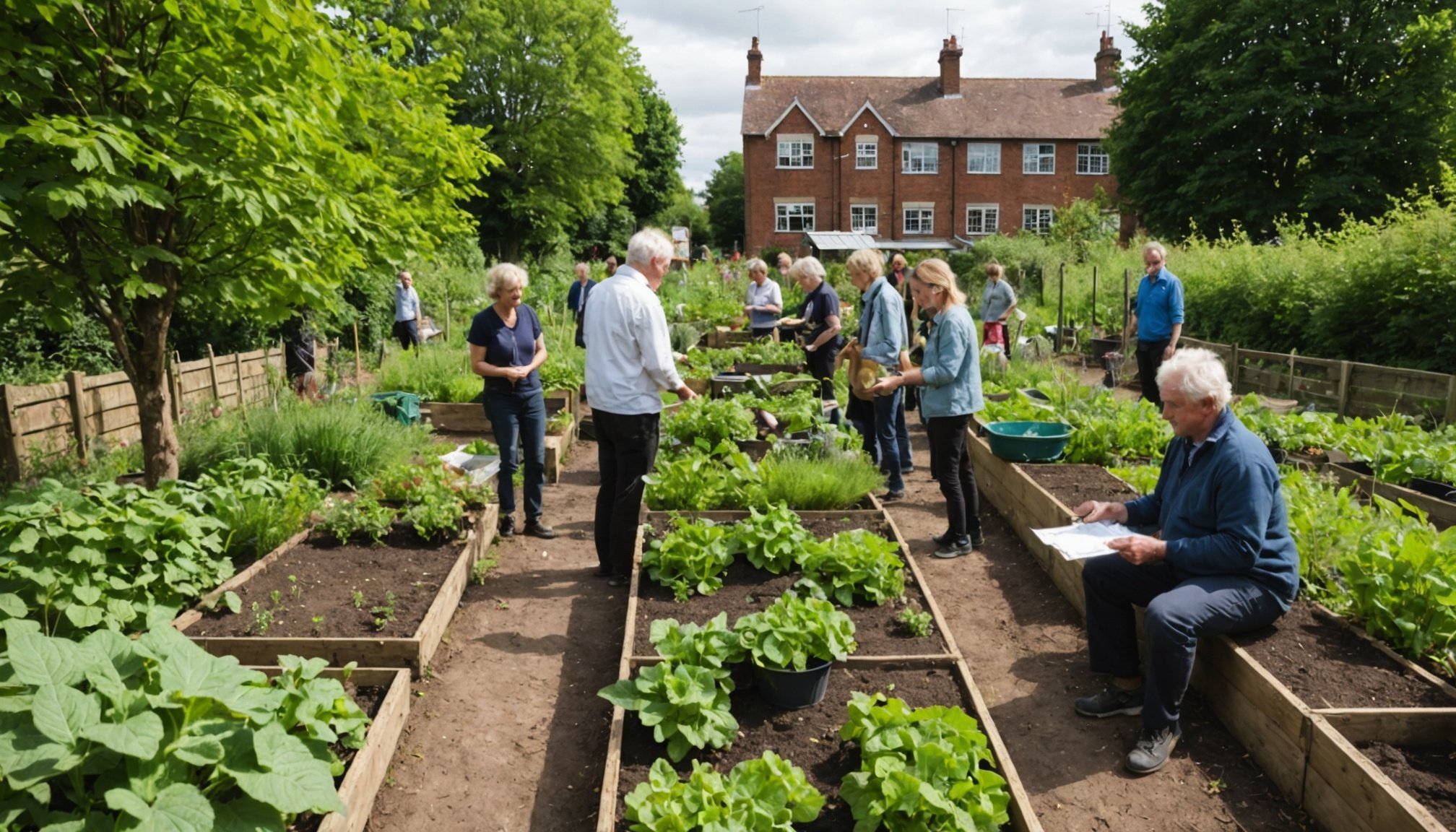The Importance of Community Gardens in Urban Biodiversity
In urban environments, community gardens serve as vital hubs for enhancing urban biodiversity by providing essential habitats. These green spaces, often created and maintained by residents, intertwine with local wildlife habitats, fostering a diverse ecosystem. Community gardens not only beautify urban areas but also support conservation efforts by providing resources like food and shelter for various species.
Role in Enhancing Biodiversity
Community gardens are microcosms of natural habitats. They attract pollinators like bees and butterflies, which are crucial for the reproduction of many plant species. The varied plant life within these gardens creates a mosaic of habitats, supporting a wide array of organisms, from small invertebrates to urban-dwelling birds.
A découvrir également : Revitalizing the UK’s Urban Waterways: Strategies to Enhance Aquatic Wildlife Habitats
Connection to Local Wildlife
Instead of isolated patches, community gardens act as stepping stones for small animals and insects, enabling them to navigate through the urban landscape. By maintaining and enhancing these gardens, urban residents contribute to the restoration and preservation of local wildlife, supporting ecological networks.
Contribution to Ecosystem Services
Community gardens also bolster ecosystem services such as air purification, climate regulation, and flood control, reinforcing urban communities’ resilience. These gardens reflect a collective commitment to enriching the urban environment and securing the delicate balance of biodiversity within city limits.
A voir aussi : Transform Your Garden: A Guide for UK Residents to Utilize Native Plants for a Wildlife-Friendly Oasis
Case Studies of UK Community Gardens
The UK community gardens serve as thriving hubs for environmental sustainability and community engagement. These gardens set exemplary standards for biodiversity, offering crucial insights into effective urban greening practices.
Notable Examples of Community Gardens
In London, the Bedford Fields Community Garden showcases remarkable flora diversity, cultivating over 100 species which enrich local biodiversity. Another inspiring example, Incredible Edible Todmorden, demonstrates how edible landscapes can transform urban areas, providing both food and community resilience.
Impact on Local Ecosystems
UK community gardens significantly enhance local ecosystems. These gardens act as sanctuaries for pollinators like bees and butterflies, essential for maintaining healthy plant populations. In particular, the Glasgow Green Community Garden creates habitats that support varied wildlife, contributing positively to urban biodiversity.
Community Engagement and Education
Community-driven programs within these gardens foster practical learning opportunities. They host workshops on sustainable gardening, engaging residents of all ages. For instance, the Hulme Community Garden Centre in Manchester offers educational programs promoting environmental awareness among local schools, aligning with wider sustainability goals. Such initiatives strengthen community bonds, promoting both ecological and social well-being.
Strategies for Establishing Community Gardens
Creating community gardens in urban spaces requires a strategic approach to ensure success and sustainability. To begin, identify a suitable location considering factors like sunlight, soil quality, and accessibility. Secure necessary permissions from local authorities before proceeding. Facilitating a community involvement plan is crucial, as it fosters a sense of ownership among participants.
Engaging local residents from the outset can help in identifying potential barriers and formulating solutions collaboratively. Conduct workshops and workshops to involve community members in the decision-making process, encouraging a shared vision for the garden project. Establishing clear communication channels is vital for ongoing community involvement and participation.
When planning gardening strategies, focus on creating a design that caters to diverse needs and preferences. Provide sections for different types of gardening, such as vegetable plots, herb corners, or flower beds. Utilizing shared resources like compost bins, rainwater harvesting systems, and community tools can aid efficiency and resource management.
For aspiring gardeners, tap into available resources such as local gardening clubs, online forums, and educational materials. Consider applying for grants or seeking sponsorships from local businesses or government initiatives to acquire necessary tools and materials. By focusing on strategic planning and cohesive community involvement, establishing community gardens can transform urban environments into vibrant green spaces.
Maintaining Urban Gardens for Biodiversity
When maintaining urban gardens, enhancing biodiversity calls for strategic garden maintenance and the adoption of sustainable practices.
Best Practices for Sustainable Gardening
Urban gardeners can contribute to biodiversity by embracing methods such as mulching, crop rotation, and the use of organic compost. These practices meticulously support the thriving of diverse plant and insect species, increasing resilience against pests and diseases, and promoting a self-sustaining ecosystem. Selecting native plant species is crucial, as they are better adapted to local conditions, making them less resource-intensive and essential for local wildlife support.
Involving the Community in Maintenance
Community involvement is vital for the continued success of biodiversity-rich gardens. Organising regular workshops or volunteer days can stimulate interest and provide education on sustainable practices. Encouraging local residents to take part in planting and maintenance creates a sense of ownership and responsibility, ensuring the longevity of diverse urban gardens.
Monitoring and Reporting Biodiversity
Systematic monitoring of biodiversity outcomes is essential. Use tools and methods, like citizen science apps, to document changes in species and plant health, helping gardeners track progress and adapt practices as needed. Successfully showcasing these results not only validates efforts but also inspires further community involvement, enhancing the garden’s role in fostering urban biodiversity.
Research Findings and Statistics
Research on community gardens has consistently revealed their positive impact on biodiversity. These green spaces serve as vital habitats for a variety of species, enhancing urban ecology by providing essential resources.
Key Statistics
Recent urban ecology studies show that community gardens can increase local species diversity by up to 25%. This is a remarkable figure, considering the limited space such gardens occupy in metropolitan areas. Additionally, specific research on community gardens indicates that these spaces support an average of 50 different plant species each, contributing to a rich tapestry of life that sustains pollinators and other urban wildlife.
Challenges and Opportunities
Despite the benefits, maintaining and enhancing biodiversity in community gardens presents several challenges. Issues such as limited funding, space constraints, and a lack of public awareness can impede progress. Moreover, urban ecology studies suggest that some gardens struggle with consistent management practices, affecting their biodiversity potential.
To address these challenges, fostering a culture of community engagement and education is essential. Enhanced support for community gardens and partnerships with ecological experts can drive forward research on community gardens. By improving management strategies and increasing public participation, urban areas can see a substantial boost in their ecological health and resilience.
Educational Aspects of Community Gardening
Community gardens serve as thriving hubs of learning and ecological interconnectedness. Through gardening education, these gardens offer invaluable opportunities to a broad audience.
Workshops and Learning Opportunities
Community workshops play a crucial role in imparting urban gardening skills. These sessions typically cover topics such as soil health, plant selection, and sustainable growing practices. Participants gain hands-on experience in composting, understanding plant needs, and optimizing small spaces for maximum yield. This type of gardening education empowers individuals, enabling them to apply these skills in personal or shared spaces, thus promoting widespread environmental stewardship.
Fostering Ecological Awareness
Community gardens significantly impact ecological awareness among participants. By engaging with nature in an urban setting, individuals become more attuned to environmental issues and sustainability. These gardens often incorporate lessons on biodiversity, waste reduction, and the benefits of organic methods. Participants learn about the ecological effects of their choices, fostering a deeper connection to the environment.
Benefits of Educational Programs
Educational programs in urban gardening benefit different age groups uniquely. For children, these programs offer a practical extension of classroom learning, enriching their understanding of biology and ecosystems. Adults gain skills that contribute to sustainable living practices. This inclusive approach also promotes community spirit and social cohesion, strengthening neighbourhood bonds through shared goals and interests.











